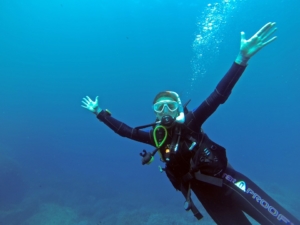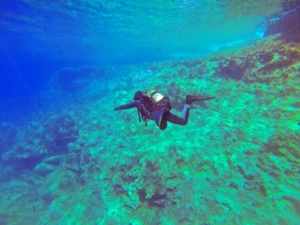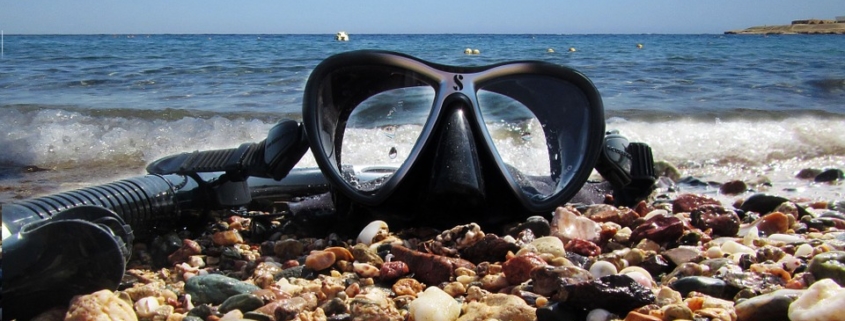It’s a problem that nearly all divers will encounter during their underwater adventures: a flooded mask. When water sneaks past the outer seal, it will enter the mask’s interior. While a small amount of water shouldn’t cause any need for concern, too much water can interfere with your vision. As a diver, you should familiarize yourself with the steps to clearing a flooded dive mask. Whether you’re training in the pool or performing a full-fledged dive off the coast, you can use this skill to quickly expunge water from your dive mask.
The Basics of Dive Masks
 Also known as a scuba mask, a dive mask is a piece of wearable diving equipment that’s used primarily to improve vision while underwater. When worn, it covers both your eyes and nose. Without a dive mask, your eyes will be exposed to the saltwater (or freshwater, depending on where you are diving). And because exposure to water prevents light from focusing on the retina of your eyes, you won’t be able to see very well.
Also known as a scuba mask, a dive mask is a piece of wearable diving equipment that’s used primarily to improve vision while underwater. When worn, it covers both your eyes and nose. Without a dive mask, your eyes will be exposed to the saltwater (or freshwater, depending on where you are diving). And because exposure to water prevents light from focusing on the retina of your eyes, you won’t be able to see very well.
A dive mask can enhance your vision while underwater, however, by creating a small amount of space between your eyes and the water. With just 1 inch of space separating your eyes from the water, light can focus on your focus on the retina of your eyes, thereby improving your vision.
What to Expect When Your Dive Mask Floods
There are dozens of types of dive masks, though most are made of silicone, rubber, tempered glass or plastic. Regardless of type, all dive masks are designed to prevent water from reaching your eyes.
Unfortunately, it’s not uncommon for water to leak into a dive mask. Known as flooding, it often occurs at the most inconvenient time. You might be 130 feet below, only to see and feel water slowly filling the inside of your dive mask. As the water level inside your dive mask climbs, it will reach your nose, followed by your eyes. Other factors can affect your underwater vision, such as current strength and the presence of sediment on the ocean floor, but you’ll struggle to see far or clearly if your dive mask floods.
Loss of vision aside, a flooded dive mask can induce a sense of panic. Depending on your depth, you may not have the luxury or quickly resurfacing to dump the water out of your dive mask. When this realization strikes, it can leave you feeling stressed and anxious, which goes against one of the top safety rules of diving: always stay calm. Anxiety doesn’t just increase your risk of making mistakes; it increases your respiratory rate, meaning you’ll consume more air.
Step #1) Take a Deep Breath Through Your Regulator
When your dive mask floods with water, calmly take a deep breath through your regulator. As you may know, the regulator is a separate piece of equipment that delivers air through a mouthpiece. Even if your dive mask floods with water, you can still breathe thanks to the regulator. And the first step to clearing a flooded dive mask is to take a deep breath through the mouthpiece and hold it.
How does taking a deep breath through your regulator help to clear a flooded dive mask exactly? The mask-clearing method described here involves pushing water out of your dive mask by exhaling. In order to exhale, though, you’ll need adequate air in your lungs. Once you’ve taken a deep breath, you can exhale to clear your flooded dive mask.
Step #2) Press on the Top of Your Dive Mask
After inhaling through your regulator, press down on the top of your dive mask with one or both hands. You should press down on the outer top rim of your dive mask rather than the transparent front. The purpose of pressing down here is to direct the water out through the bottom of your dive mask. If you don’t press down on the bottom of your dive mask, exhaling may break the upper seal of your mask, allowing more water to enter. Obviously that would be counterproductive to what you are trying to achieve, so press on the top of your dive mask around the rim.
Step #3) Exhale Through Your Nose
The third and final step to clearing a flooded dive mask is to exhale through your nose. While still pressing down on the outer top rim of your dive mask, steadily exhale through your nose using moderate force. When performed correctly, this will force the collected water out of your dive mask.
Keep in mind that you may have to repeat these steps several times. If your dive mask is only 20% flooded, one or two strong exhales should clear it. If your dive mask is completely flooded, however, it may take a half-dozen or more exhales.
Tighten the Strap
If you discover that your dive mask is constantly flooding with water, try tightening the strap. Not surprisingly, a loose strap is one of the leading causes of flooded dive masks. When it’s loose, your dive mask won’t be able to create a waterproof seal around your face. It may only leak under certain conditions, such as when ascending or descending, or it may leak all the time. To reduce the risk of your dive mask leaking, adjust the strap so it’s relatively tight around your head. Just remember not to make it too tight, as this can cause discomfort or pain.
Clean the Skirt
Another tip to prevent water from leaking into your dive mask is to clean your mask’s skirt. The skirt is a band of soft material, usually synthetic rubber or silicone, around the inside perimeter of a dive mask that acts as a waterproof seal. Over time, dirt, debris or oils from your skin will accumulate on the skirt. If you dive mask’s skirt becomes too dirty, water may leak past it. To clean your dive mask’s skirt, wipe it with a wet washcloth and a small amount of liquid dish soap. You don’t have to clean the skirt every time you go diving, but you should get into the habit of cleaning it on a regular basis. By keeping the skirt clean, water is less likely to enter and flood your dive mask.
Switch to a Full-Face Dive Mask
 When all else fails, consider switching to a full-face dive mask. Full-face dive masks cover your entire head, and many of them feature a drain valve that’s designed specifically to remove water. Just engage the drain valve, at which point water will flush out the mask. Some full-face dive masks even have an automatic clearing function in which you tilt or raise your head to remove water. Full-face dive masks are larger and bulkier than traditional dive masks, but they are less likely to flood with water than their counterparts.
When all else fails, consider switching to a full-face dive mask. Full-face dive masks cover your entire head, and many of them feature a drain valve that’s designed specifically to remove water. Just engage the drain valve, at which point water will flush out the mask. Some full-face dive masks even have an automatic clearing function in which you tilt or raise your head to remove water. Full-face dive masks are larger and bulkier than traditional dive masks, but they are less likely to flood with water than their counterparts.
Don’t let a flooded dive mask prevent you from enjoying your dives. When water begins creeping into your dive mask, use the three-step technique described here to clear it. Alternatively, switch to a full-face dive mask with a drain valve. By keeping your dive mask free of water, you’ll have a safer and more enjoyable experiencing when diving.
Want to create your own custom dive logs? Contact us today to learn more about our custom dive logs.



